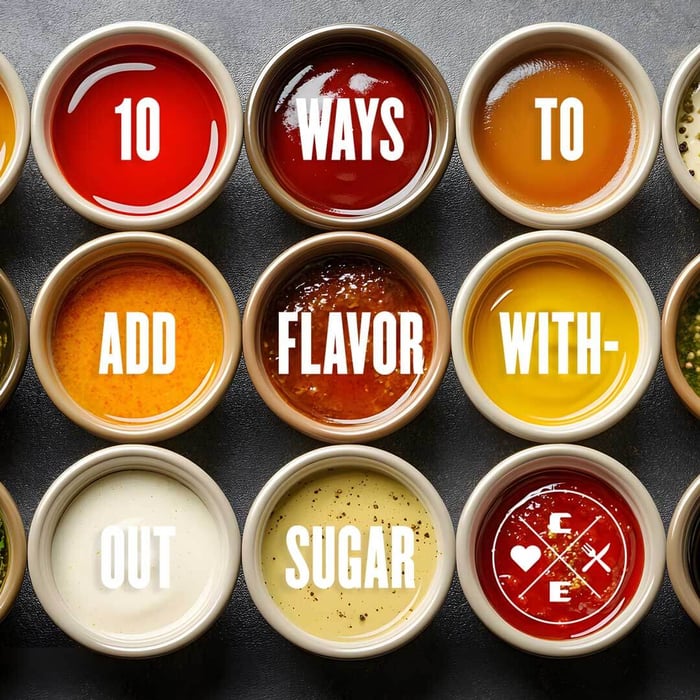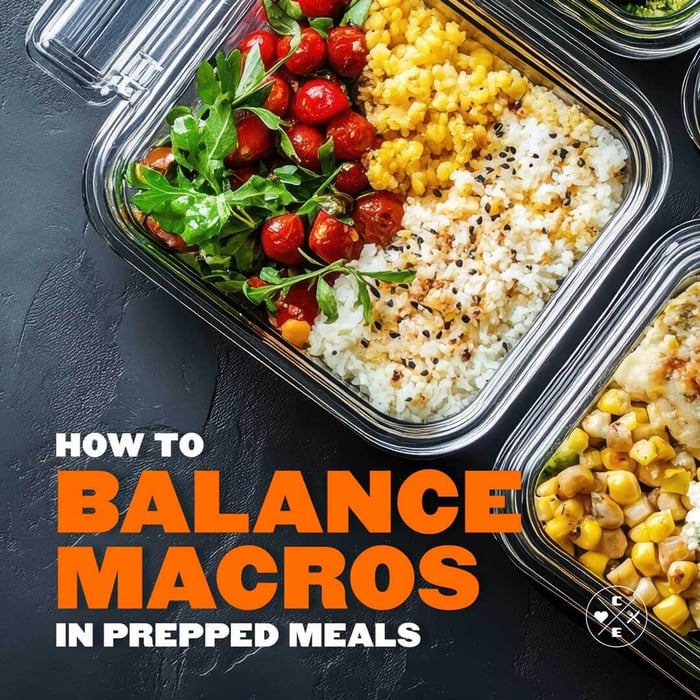Sugar-Free Cooking: 10 Ways to Add Flavor Without Sugar

Jason Nista
Nutrition
|
Healthy Recipes
01/10/2025 6:38am
13 minute read
Reducing sugar doesn't mean sacrificing flavor. Here are 10 simple ways to make your meals taste amazing without adding sugar:
- Herbs & Spices: Add bold flavors like turmeric, rosemary, ginger, or basil.
- Citrus Zest & Juice: Use lemon, lime, orange, or grapefruit for brightness.
- Vinegars & Fermented Foods: Try balsamic, apple cider vinegar, or kimchi for tangy depth.
- Caramelized Vegetables: Slow-cook onions, carrots, or sweet potatoes for natural sweetness.
- Peppers & Chili Flakes: Add heat with jalapeños, cayenne, or ancho chili flakes.
- Mushrooms & Soy Sauce: Enhance savory umami flavors with shiitake mushrooms or soy sauce.
- Garlic & Onions: Sauté, roast, or caramelize for rich, layered flavors.
- Toasted Nuts & Seeds: Add crunch and flavor with almonds, walnuts, or pumpkin seeds.
- Infused Oils: Create flavored oils with garlic, rosemary, or chili.
- Healthy Meal Services: Consider options like Clean Eatz Kitchen for sugar-free, flavorful meals.
These techniques make it easy to cook delicious meals while cutting back on sugar. Start experimenting with one or two methods today!
1. Use Herbs and Spices
Herbs and spices are a key way to add flavor without relying on sugar. They bring bold tastes to your meals and can even offer added health perks [3][1].
For the best results, use fresh herbs toward the end of cooking to keep their vibrant flavor intact. Dried herbs, on the other hand, work best when added earlier, giving them time to infuse their essence into the dish [1].
Here are a few versatile options to experiment with:
- Turmeric: Perfect for curries, stews, and soups
- Rosemary: Great with roasted meats and vegetables
- Ginger: Ideal for stir-fries and beverages
- Basil: A go-to for Italian dishes and salads
Start with small amounts and adjust as needed to avoid overwhelming the dish [1]. To keep your herbs and spices at their best, store them in airtight containers, away from heat and moisture [3].
Once you've mastered these, try using citrus zest or juice to add a natural, tangy brightness to your meals.
2. Use Citrus Zest and Juice
Citrus zest and juice pack a punch when it comes to boosting flavors. The zest provides concentrated oils for a bold kick, while the juice adds acidity and a touch of sweetness. To get the zest, use a fine grater and be careful to avoid the bitter white part underneath.
"A little fresh lemon, orange, or lime juice can really bring out the flavor of a recipe" [1]
Different citrus fruits bring their own unique qualities to the table:
| Citrus Type | Best Uses and Flavor Profile |
|---|---|
| Lemon | Bright and tangy - perfect for marinades, seafood, and dressings |
| Orange | Slightly sweet - great for glazes and Asian-inspired dishes |
| Lime | Tart and sharp - ideal for Mexican dishes and marinades |
| Grapefruit | A mix of bitter and sweet - excellent for vinaigrettes and seafood |
Loaded with vitamin C and antioxidants, citrus can also support your immune system and overall well-being [1]. Pair citrus with ingredients like garlic and herbs for savory dishes, or spices like cinnamon and nutmeg for sweeter recipes. Start with small amounts to avoid overpowering your dish, then adjust as needed.
Once you’re comfortable with citrus, try experimenting with vinegars and fermented foods to add even more layers of flavor to your cooking.
3. Use Vinegars and Fermented Foods
Vinegars and fermented foods naturally boost flavor while offering benefits like probiotics and antioxidants that support gut health. By using these ingredients, you can skip sugary condiments and still achieve rich, satisfying flavors.
| Vinegar Type | Flavor Profile | Best Uses |
|---|---|---|
| Balsamic | Sweet and tangy | Glazes, dressings |
| Apple Cider | Fruity and sharp | Marinades, sauces |
| White Wine | Crisp and light | Seafood, pickling |
| Sherry | Nutty and complex | Vinaigrettes, sauces |
A splash of vinegar can brighten up a dish - just add it gradually to fit your taste. For soups or stews, stir it in near the end of cooking to keep its vibrant flavor intact. Pair vinegars with healthy fats like olive oil to create balanced dressings or marinades [1].
Fermented foods bring a savory depth to meals while packing probiotics [1][3]. Some great options to try:
- Kimchi: Perfect for stir-fries or Korean-inspired dishes
- Sauerkraut: Adds tang to salads and sandwiches
- Miso Paste: Ideal for savory marinades and sauces
For dietary restrictions, swap traditional soy sauce for gluten-free tamari [1]. Try drizzling balsamic over roasted veggies or mixing kimchi into fried rice for quick, flavorful upgrades without added sugar.
Once you’ve explored vinegars and fermented foods, caramelized vegetables can add natural sweetness to your dishes, keeping them both healthy and delicious.
4. Caramelize Vegetables for Sweetness
Slow cooking brings out the natural sweetness in vegetables, creating rich, deep flavors. The secret lies in using the right technique and choosing the right vegetables:
| Vegetable | Time & Temperature |
|---|---|
| Onions | 45-60 minutes, low-medium heat |
| Carrots | 20-25 minutes, medium heat |
| Bell Peppers | 15-20 minutes, medium heat |
| Sweet Potatoes | 25-30 minutes, medium heat |
Start with a heavy-bottomed pan and add a little oil. Cook over medium heat until the vegetables brown, then reduce the heat to prevent burning. If they begin to stick, deglaze the pan with a splash of water or broth to release those flavorful bits without adding more oil. The process takes time, but rushing will only lead to uneven cooking or burning.
This method triggers the Maillard reaction, amplifying flavors while keeping nutrients like fiber and vitamins intact. Use caramelized onions in soups, sweet carrots in grain bowls, or tender bell peppers in pasta dishes. To get the best results, avoid overcrowding the pan - too many vegetables will steam instead of caramelize.
Once you've nailed caramelizing vegetables, take your cooking up a notch by experimenting with heat from chili flakes or peppers to add bold, sugar-free flavor to your meals.
5. Add Heat with Peppers and Chili Flakes
Peppers and chili flakes pack a punch with their natural spiciness, adding bold, sugar-free flavor to your meals. The key is choosing the right pepper for your dish based on its heat level and flavor:
| Pepper Type | Heat Level | Best Uses |
|---|---|---|
| Jalapeño | Moderate | Tacos, salads, stir-fries |
| Ancho Chili Flakes | Mild | Soups, marinades, sauces |
| Cayenne Flakes | Intense | Hot sauces, spicy dishes |
| Habanero | Very Hot | Marinades, hot sauces |
Start small when adding heat, and gradually increase until you hit the perfect balance. For stir-fries, add fresh peppers early to infuse the oil with their flavor. In soups, sprinkle chili flakes at the start to ensure the heat is evenly distributed.
Peppers are more than just spicy - they’re loaded with vitamins A and C and contain compounds that may help reduce inflammation [2]. To keep them fresh, store chili flakes in airtight containers and freeze fresh peppers for later use.
Taste as you cook, adjusting the heat to complement your dish rather than overpower it. Whether you're whipping up a quick stir-fry or crafting a complex sauce, peppers and chili flakes can turn sugar-free meals into something truly satisfying.
Once you’ve mastered the art of adding heat, consider experimenting with ingredients like mushrooms or soy sauce to create deeper, richer flavors.
sbb-itb-1989a25
6. Use Mushrooms and Soy Sauce for Umami
Umami, the savory "fifth taste", adds rich, satisfying flavors to dishes without relying on sugar. This taste makes meals more enjoyable while reducing the need for sweeteners.
Mushrooms and soy sauce are excellent sources of umami. Mushrooms like shiitake, porcini, and portobello bring distinct flavors, while soy sauce delivers a concentrated punch with just a small amount.
| Mushroom Type | Umami Level | Best Uses |
|---|---|---|
| Shiitake | Very High | Broths, stir-fries, sauces |
| Porcini | High | Risottos, pasta dishes, soups |
| Portobello | Medium | Grilling, roasting, stuffing |
| Oyster | Medium-High | Sautéing, stews, noodle dishes |
To get the most umami from mushrooms:
- Sauté them in a single layer over medium heat until golden brown. This helps release their deep, savory flavors.
- Use dried mushrooms and include their soaking liquid for an extra flavor boost.
When it comes to soy sauce, start with 1/2 to 1 teaspoon and adjust to your taste. If you're watching your sodium intake, low-sodium varieties are a great option and still provide plenty of flavor.
Here’s a quick trick for an umami-packed base: Sauté finely chopped mushrooms until they release their moisture and start to brown. Add a splash of soy sauce near the end of cooking and let it reduce slightly. This creates a rich, flavorful mix that works perfectly in soups, sauces, or marinades.
Beyond flavor, mushrooms and soy sauce offer health benefits like antioxidants, immune support, and heart-friendly compounds. For soy sauce, choose naturally brewed options for added nutrients like isoflavones, which are good for heart health.
Once you've mastered these umami-rich ingredients, consider adding toasted nuts and seeds to your sugar-free recipes for extra texture and depth.
7. Use Garlic and Onions for Flavor
Garlic and onions are key ingredients that can elevate a dish from plain to flavorful without relying on sugar. These aromatic vegetables add layers of taste through their natural compounds, making them a perfect substitute for sugar-heavy sauces or dressings.
How you cook garlic and onions can dramatically change their flavor:
| Cooking Method | Flavor Profile | Common Uses |
|---|---|---|
| Raw | Sharp, pungent | Dressings, dips, marinades |
| Sautéed | Mild, aromatic | Stir-fries, soups, sauces |
| Roasted | Sweet, mellow | Spreads, purees, garnishes |
| Caramelized | Deep, rich | Toppings, bases, condiments |
For garlic, try crushing or mincing it and letting it rest for 10-15 minutes before cooking. This process activates allicin, the compound that gives garlic its bold flavor and health benefits. Want a different twist? Experiment with shallots for a milder taste or red onions for a bolder kick.
Both garlic and onions also pack a nutritional punch. Garlic is linked to heart health, while onions are known for boosting immunity thanks to their antioxidants.
Pro tip: Build a flavorful base by slowly cooking diced onions until golden (refer to Section 4 for caramelization tips). Add minced garlic in the last few minutes to avoid burning it, which can make it taste bitter. This combination works wonders for soups, stews, and sauces without needing added sugar.
If you want a softer garlic flavor, roast whole bulbs at 400°F (200°C) for 40 minutes. Drizzle them with olive oil and wrap in foil before roasting for a mellow, sweet taste.
Timing is key when using these ingredients. Onions benefit from a longer cooking time to develop their natural sweetness, while garlic should be added later in the process to avoid burning. Once your base is ready, consider adding toasted nuts or seeds for extra texture and richness.
8. Use Toasted Nuts and Seeds
Toasting nuts and seeds brings out their natural flavors, giving you a sugar-free way to boost both taste and texture in your dishes.
When toasted, the oils in nuts and seeds are released, creating deeper flavors and a satisfying crunch. To toast them, set your oven to 350°F (175°C), spread them out in a single layer, and roast for 5-10 minutes. Keep a close eye on them - burnt nuts can taste bitter.
Here's how different types of nuts and seeds change when toasted:
| Type | Flavor Profile | Best Uses |
|---|---|---|
| Almonds | Aromatic, buttery | Salads, baked goods, granola |
| Walnuts | Rich, earthy | Pasta dishes, roasted vegetables |
| Pumpkin Seeds | Nutty, complex | Soups, breakfast bowls |
| Sunflower Seeds | Mild, toasty | Trail mixes, yogurt toppings |
Toasted nuts and seeds not only taste great but also provide nutrients like healthy fats, protein, and fiber. For storage, keep them in an airtight container for up to two weeks or refrigerate for three months. Toast each type separately for the best results, then mix them to create custom blends.
Expert tip: Experiment with blends to complement your meals. For example, mix toasted pumpkin seeds with almonds for a crunchy salad topping, or pair walnuts with sunflower seeds to add texture to roasted vegetables.
You can also combine toasted nuts and seeds with caramelized onions or roasted garlic for rich, sugar-free flavor combinations. Once you’ve mastered toasting, take it a step further by infusing oils with aromatics to add even more depth to your cooking.
9. Infuse Oils with Aromatics
Infused oils are a fantastic way to elevate dishes with bold, sugar-free flavors, making them a great alternative to sugary condiments or dressings. With just a few steps, you can transform plain cooking oil into a flavorful addition to your meals.
The secret to a great infused oil lies in choosing the right base oil and aromatics. Extra virgin olive oil is a popular choice, while cold-pressed oils bring added nutritional perks. Pair your oil with aromatics like these:
| Base Oil | Aromatics | Best Uses |
|---|---|---|
| Olive Oil | Garlic + Rosemary | Roasting, soups |
| Avocado Oil | Lemon Zest + Herbs | Dressings, marinades |
| Grapeseed Oil | Chili + Garlic | Stir-fries, sautéing |
To make your own infused oil, combine the aromatics and oil in a sterilized jar, give it a shake, and let it sit until the flavors develop. Depending on the ingredients, this can take anywhere from a few hours to a few days.
Safety tip: Always use clean tools, store the oil in a cool, dark place, and consume it within two weeks to keep it safe and fresh.
Here are some ways to use infused oils:
- Drizzle herb-infused oil over roasted vegetables for a flavor boost.
- Add garlic-infused oil to sugar-free salad dressings.
- Brush lemon-herb oil onto grilled meats or fish.
- Stir in chili oil to soups or stews for a spicy kick.
Infused oils not only bring healthy fats to your meals but also add the benefits of ingredients like garlic and rosemary, which are known for their antioxidant and heart-friendly properties.
Expert tip: Start with small batches to experiment with flavors. Strain the oil before using it for a smoother finish.
If you’re short on time but still crave flavorful, sugar-free meals, consider exploring meal delivery services for quick and tasty options.
10. Consider Healthy Meal Delivery Services like Clean Eatz Kitchen
![]()
Meal delivery services such as Clean Eatz Kitchen provide a convenient way to enjoy chef-prepared meals that are free from added sugars. They use professional techniques and natural ingredients to craft dishes that are both healthy and flavorful.
| Technique | How It's Done | Why It Helps |
|---|---|---|
| Natural Flavoring | Fresh herbs, spices, and balancing | Delivers rich, sugar-free taste |
| Portion Control | Pre-measured servings | Supports healthy eating habits |
Clean Eatz Kitchen demonstrates how natural methods can create flavorful, sugar-free meals. Their menu includes options that highlight ingredients like caramelized vegetables, umami flavors, and fresh herbs, proving that healthy meals can still taste amazing.
They offer a variety of dietary plans, such as weight loss and gluten-free options, all designed to eliminate added sugars without compromising on taste. The chef-curated recipes incorporate flavor-boosting techniques covered earlier, showing that eating well doesn’t mean giving up on flavor.
Whether you prefer to cook yourself or opt for a service like Clean Eatz Kitchen, you can enjoy meals that are both nutritious and delicious.
Conclusion
Boosting flavor without relying on sugar is absolutely doable and can make your meals even more enjoyable. Using natural ingredients and simple cooking methods, you can whip up dishes that are both tasty and healthier.
Techniques like caramelization, adding umami-rich ingredients, or incorporating citrus can naturally bring out bold flavors in your meals. Start small - try one or two methods - and build from there as you get the hang of it. These approaches not only help cut back on sugar but also make your meals more satisfying.
Whether you're preparing meals at home or opting for healthy meal services, these tricks can reshape how you think about healthy eating. The result? Flavor-packed dishes that keep sugar in check while delivering on taste and nutrition.
Related Articles
How to Balance Macros in Prepped Meals
8 minute read
How Gut Health Impacts Muscle Recovery
7 minute read



